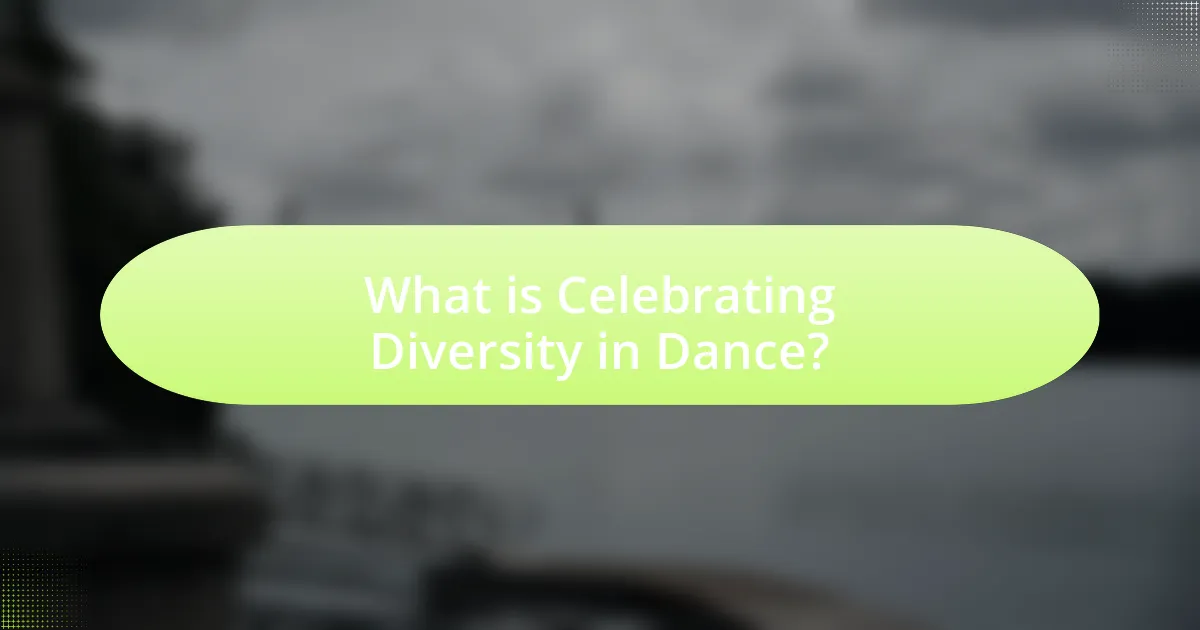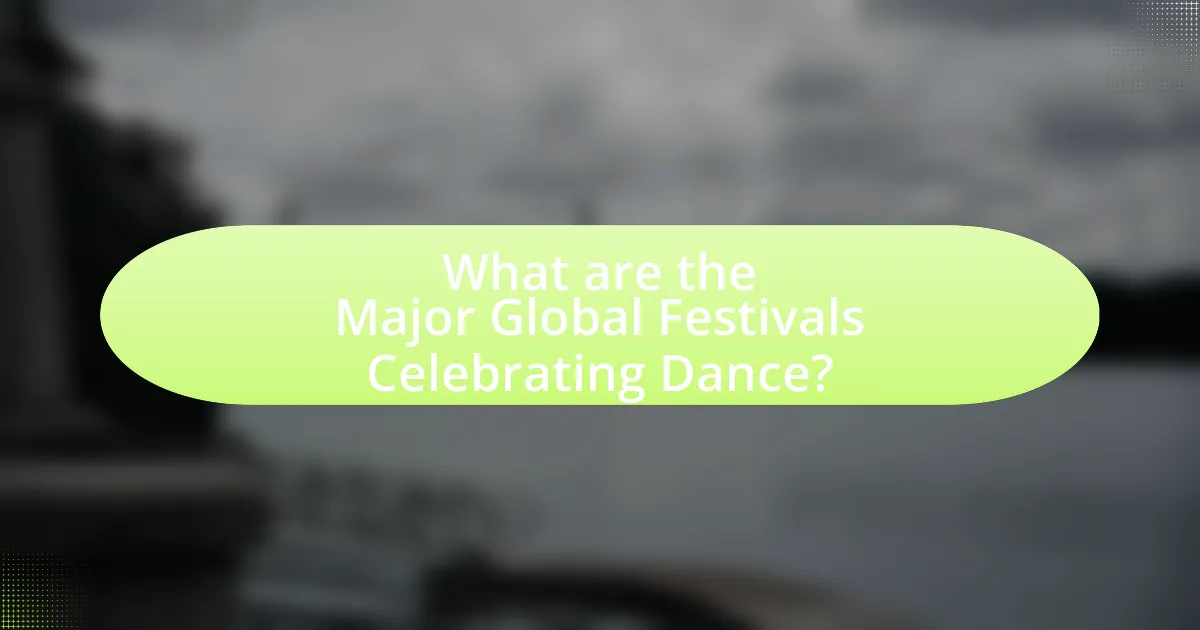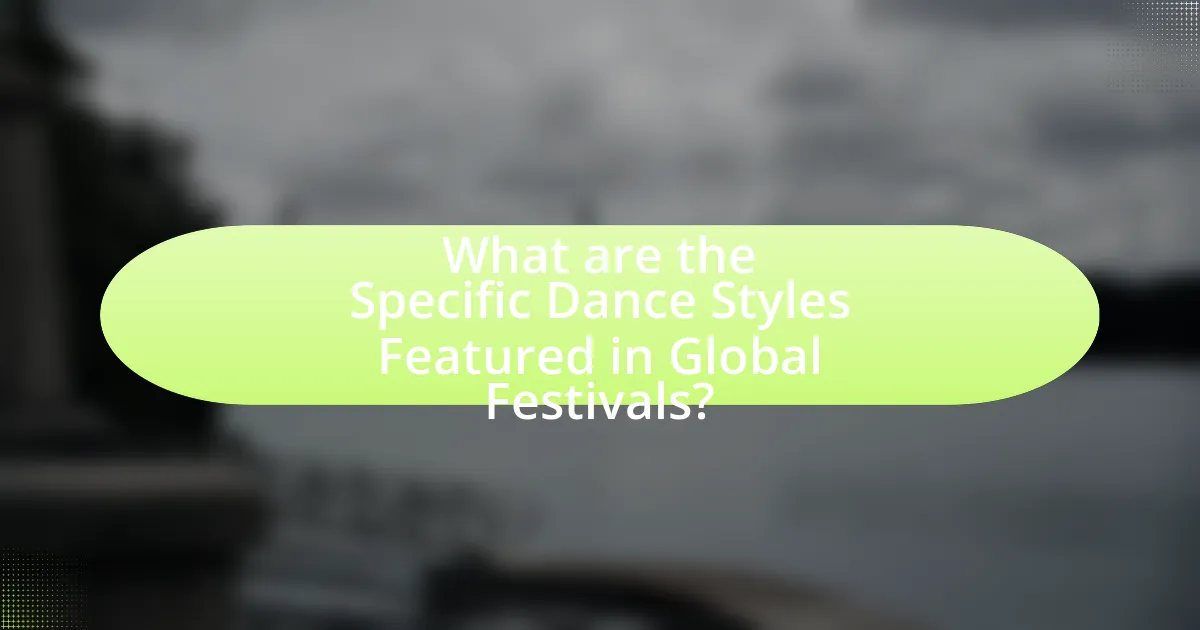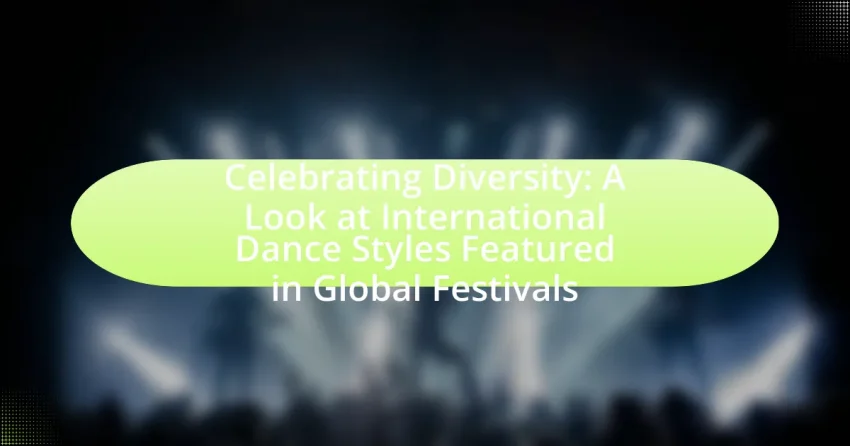Celebrating Diversity in Dance highlights the recognition and appreciation of various dance forms from different cultures worldwide. The article explores how international dance styles, such as Flamenco, Bharatanatyam, and Hula, reflect cultural diversity and convey unique narratives, values, and aesthetics. It discusses the significance of global festivals, such as the Edinburgh Festival Fringe and the Rio Carnival, in promoting cultural exchange and understanding through dance. Additionally, the article examines the characteristics of various dance styles, the influence of historical contexts, and the role of dance in cultural identity and community cohesion.

What is Celebrating Diversity in Dance?
Celebrating Diversity in Dance refers to the recognition and appreciation of various dance forms that originate from different cultures around the world. This concept emphasizes the importance of showcasing and honoring the unique traditions, styles, and movements that define each culture’s dance heritage. Events such as global festivals serve as platforms for this celebration, allowing diverse dance styles to be performed and shared, thereby fostering cultural exchange and understanding. For instance, festivals like the Edinburgh Festival Fringe and the International Dance Festival in Birmingham highlight a wide array of international dance styles, promoting inclusivity and respect for cultural differences.
How do international dance styles reflect cultural diversity?
International dance styles reflect cultural diversity by showcasing the unique traditions, histories, and social practices of various communities around the world. Each dance form, such as Flamenco from Spain, Bharatanatyam from India, or Hula from Hawaii, embodies specific cultural narratives, values, and aesthetics that are integral to the identity of the people who perform them. For instance, Flamenco incorporates elements of Spanish history, including influences from Gypsy, Moorish, and Andalusian cultures, illustrating the complex interplay of cultural influences in its development. Similarly, Bharatanatyam, one of the oldest classical dance forms in India, conveys religious and mythological stories through intricate movements and expressions, reflecting the spiritual and cultural heritage of South India. These dance styles not only serve as artistic expressions but also act as vehicles for cultural preservation and exchange, allowing audiences to engage with and appreciate the rich tapestry of global cultures.
What are the key characteristics of various international dance styles?
International dance styles exhibit distinct characteristics that reflect their cultural origins and historical contexts. For example, ballet is known for its formalized movements, precision, and emphasis on technique, often performed in a theatrical setting. In contrast, salsa incorporates lively, rhythmic footwork and partner interaction, originating from Latin American dance traditions.
Similarly, Bharatanatyam, a classical Indian dance, is characterized by intricate footwork, expressive hand gestures (mudras), and storytelling through facial expressions, rooted in ancient temple rituals. African dance styles, such as West African dance, emphasize community participation, improvisation, and rhythmic body movements that connect to cultural celebrations and rituals.
Moreover, traditional Chinese dance features fluid movements and storytelling elements, often accompanied by elaborate costumes and music, reflecting China’s rich history. Each of these styles not only showcases unique physical techniques but also embodies the cultural narratives and social values of their respective societies.
How do historical contexts influence these dance styles?
Historical contexts significantly influence dance styles by shaping their themes, movements, and cultural significance. For instance, the African diaspora led to the development of various dance forms like salsa and samba, which reflect the historical experiences of African communities in the Americas. Additionally, the influence of colonialism on indigenous dance styles can be seen in the incorporation of European elements into traditional dances, as observed in the fusion of flamenco with gypsy and Moorish influences in Spain. These historical narratives are embedded in the choreography and music, making dance a living expression of cultural identity and historical memory.
Why is it important to celebrate diversity through dance?
Celebrating diversity through dance is important because it fosters understanding and appreciation of different cultures. Dance serves as a universal language that transcends barriers, allowing individuals to connect with diverse traditions and histories. For instance, global festivals often showcase various dance styles, such as African tribal dances, Indian classical forms, and Latin rhythms, which highlight the unique cultural narratives and values of each community. This exposure not only enriches participants’ experiences but also promotes social cohesion and respect among different ethnic groups, as evidenced by studies indicating that cultural exchange through the arts can reduce prejudice and enhance community ties.
What role does dance play in cultural identity?
Dance serves as a vital expression of cultural identity, reflecting the values, traditions, and history of a community. It acts as a medium through which cultural narratives are conveyed, allowing individuals to connect with their heritage and share it with others. For instance, traditional dances often incorporate specific movements, music, and attire that are unique to a culture, reinforcing a sense of belonging and continuity. Research indicates that dance can enhance social cohesion and cultural pride, as seen in various global festivals where communities showcase their traditional dances, fostering intercultural understanding and appreciation.
How can dance promote understanding and acceptance among cultures?
Dance promotes understanding and acceptance among cultures by serving as a universal language that transcends verbal communication. Through shared movements, rhythms, and expressions, dance allows individuals from diverse backgrounds to connect emotionally and culturally. For instance, international dance festivals showcase various styles, such as Flamenco from Spain or Bharatanatyam from India, enabling participants and audiences to appreciate the unique cultural narratives and histories behind each dance form. This exposure fosters empathy and respect, as individuals learn about the traditions and values of other cultures, ultimately leading to greater social cohesion and acceptance.

What are the Major Global Festivals Celebrating Dance?
Major global festivals celebrating dance include the Rio Carnival in Brazil, the Edinburgh Festival Fringe in Scotland, and the Notting Hill Carnival in the UK. The Rio Carnival, held annually before Lent, features samba parades and attracts millions of participants and spectators, showcasing Brazil’s rich cultural heritage. The Edinburgh Festival Fringe, the world’s largest arts festival, includes numerous dance performances from various styles, highlighting international talent and creativity. The Notting Hill Carnival celebrates Caribbean culture with vibrant dance and music, drawing over a million attendees each year. These festivals exemplify the diversity and global appreciation of dance as an art form.
Which festivals are known for showcasing international dance styles?
Festivals known for showcasing international dance styles include the Edinburgh Festival Fringe, the International Dance Festival Birmingham, and the World Dance Alliance Global Summit. The Edinburgh Festival Fringe, held annually in Scotland, features a diverse range of performances, including traditional and contemporary dance from various cultures. The International Dance Festival Birmingham, taking place in the UK, presents a platform for international dance companies to perform and engage with local audiences. The World Dance Alliance Global Summit, occurring in different countries, brings together dancers and choreographers from around the world to share their art forms and promote cultural exchange. These festivals are recognized for their commitment to celebrating global dance traditions and fostering intercultural dialogue.
What unique features do these festivals offer to participants and audiences?
These festivals offer unique features such as immersive cultural experiences, diverse dance workshops, and live performances that showcase various international dance styles. Participants engage directly with artists, learning techniques and cultural contexts behind each dance form, which enhances their understanding and appreciation of global traditions. Audiences benefit from the vibrant atmosphere created by colorful costumes, live music, and interactive performances, fostering a sense of community and cultural exchange. For instance, events like the Edinburgh Festival Fringe feature over 3,000 performances, highlighting the diversity of artistic expression and attracting participants and audiences from around the world.
How do these festivals contribute to the preservation of cultural heritage?
Festivals contribute to the preservation of cultural heritage by serving as platforms for the performance and transmission of traditional dance styles. These events allow communities to showcase their unique cultural identities, fostering intergenerational knowledge transfer as older generations teach younger participants the significance and techniques of their traditional dances. For example, the annual Festival of World Cultures in Ireland features various international dance forms, enabling cultural exchange and appreciation, which reinforces the importance of maintaining these traditions. Additionally, festivals often include workshops and educational programs that engage attendees, further solidifying the cultural practices associated with the dances.
How do festivals facilitate cultural exchange through dance?
Festivals facilitate cultural exchange through dance by providing a platform for diverse communities to showcase their traditional and contemporary dance forms. This interaction allows participants and audiences to experience and appreciate different cultural expressions, fostering mutual understanding and respect. For instance, events like the Edinburgh Festival Fringe and the International Dance Festival in Birmingham feature performances from various countries, enabling artists to share their heritage while engaging with global audiences. Such exchanges often lead to collaborations and the blending of styles, further enriching the cultural landscape.
What opportunities do festivals provide for collaboration among dancers?
Festivals provide numerous opportunities for collaboration among dancers by facilitating cross-cultural exchanges and creating platforms for joint performances. These events often bring together diverse dance styles and traditions, allowing dancers to learn from one another and experiment with fusion choreography. For instance, festivals like the Edinburgh Festival Fringe showcase international artists, enabling dancers to collaborate on stage and share techniques, which enhances their artistic development. Additionally, workshops and masterclasses offered during these festivals encourage interaction and networking, fostering partnerships that can lead to future collaborative projects.
How do festivals impact local communities economically and socially?
Festivals significantly impact local communities both economically and socially by driving tourism and fostering community engagement. Economically, festivals attract visitors who spend money on accommodations, food, and local attractions, which can lead to increased revenue for local businesses. For instance, a study by the National Endowment for the Arts found that arts festivals can generate up to $1.5 million in economic activity for small towns. Socially, festivals promote cultural exchange and community cohesion, as they bring together diverse groups to celebrate shared traditions and values. This interaction can enhance social networks and strengthen community identity, as evidenced by research from the University of California, which indicates that participation in community festivals increases social capital and civic engagement.

What are the Specific Dance Styles Featured in Global Festivals?
Global festivals feature a variety of specific dance styles that represent cultural diversity. Prominent dance styles include Flamenco from Spain, which is characterized by its passionate movements and intricate footwork; Bharatanatyam from India, known for its expressive gestures and storytelling; and Samba from Brazil, recognized for its lively rhythm and energetic movements. Additionally, traditional Irish dance showcases rapid footwork and intricate patterns, while the Hula from Hawaii emphasizes storytelling through graceful body movements. These dance styles not only entertain but also serve as cultural expressions, reflecting the heritage and traditions of their respective regions.
What are some prominent international dance styles showcased at festivals?
Prominent international dance styles showcased at festivals include Flamenco, Bharatanatyam, Salsa, and Hula. Flamenco, originating from Spain, is characterized by its passionate footwork and intricate hand movements. Bharatanatyam, a classical dance from India, features expressive gestures and storytelling through dance. Salsa, which has roots in Latin America, is known for its energetic and rhythmic movements. Hula, from Hawaii, incorporates storytelling through graceful hip movements and hand gestures. These styles not only represent their cultural origins but also attract global audiences, highlighting the diversity of dance at international festivals.
How do traditional dances differ from contemporary interpretations?
Traditional dances are characterized by their adherence to cultural heritage, specific techniques, and historical significance, while contemporary interpretations often incorporate modern influences, innovative choreography, and diverse styles. Traditional dances, such as the Irish jig or Indian Bharatanatyam, are rooted in specific cultural narratives and rituals, often passed down through generations, maintaining their original forms and meanings. In contrast, contemporary interpretations may blend various dance styles, utilize new technologies, and reflect current social themes, leading to a more fluid and evolving expression of movement. For example, contemporary dance often emphasizes personal expression and improvisation, diverging from the structured forms of traditional dances. This distinction highlights the dynamic nature of dance as both a cultural artifact and a medium for modern artistic exploration.
What are the origins and significance of specific dance styles?
Dance styles originate from various cultural, historical, and social contexts, reflecting the traditions and values of the communities from which they emerge. For example, ballet originated in the Italian Renaissance courts of the 15th century and evolved in France and Russia, symbolizing grace and discipline. In contrast, African dance styles, such as West African traditional dances, have roots in communal rituals and storytelling, emphasizing community and cultural identity. The significance of these dance styles lies in their ability to convey emotions, tell stories, and foster social cohesion, serving as a medium for cultural expression and preservation. Additionally, dance styles like salsa, which originated in the Caribbean and Latin America, highlight the fusion of diverse musical influences and social interactions, showcasing the dynamic nature of cultural exchange.
How do dancers prepare for performances at international festivals?
Dancers prepare for performances at international festivals through rigorous training, choreography refinement, and cultural research. They engage in daily practice sessions to enhance their technique and stamina, often dedicating several hours to perfecting their routines. Additionally, dancers collaborate with choreographers to adapt their performances to fit the festival’s theme and audience expectations, ensuring that their routines resonate culturally and artistically. Researching the cultural significance of their dance styles is also crucial, as it allows dancers to authentically represent their heritage and connect with diverse audiences. This preparation is validated by the fact that successful festival performances often require a deep understanding of both the technical and cultural aspects of the dance, as highlighted in studies on performance arts and cultural representation.
What training and rehearsal practices are common among dancers?
Common training and rehearsal practices among dancers include daily technique classes, strength and conditioning workouts, and regular rehearsals for performances. Technique classes focus on developing foundational skills specific to various dance styles, such as ballet, contemporary, or hip-hop, ensuring dancers maintain proper form and execution. Strength and conditioning workouts enhance physical fitness, flexibility, and endurance, which are crucial for performance quality. Regular rehearsals allow dancers to practice choreography, refine their movements, and build ensemble cohesion, often guided by choreographers or instructors. These practices are essential for achieving proficiency and artistry in dance, as evidenced by the structured training regimens seen in professional dance companies worldwide.
How do dancers adapt their styles for diverse audiences?
Dancers adapt their styles for diverse audiences by incorporating elements that resonate with the cultural backgrounds and preferences of those audiences. This adaptation often involves modifying choreography, music selection, and costume design to reflect local traditions and values. For instance, dancers performing at international festivals may blend traditional movements with contemporary styles to appeal to a broader demographic, ensuring that their performance is both relatable and engaging. Research indicates that such adaptations can enhance audience connection and appreciation, as seen in events like the Edinburgh Festival Fringe, where performers tailor their acts to reflect the cultural diversity of attendees.
What are some best practices for engaging with international dance styles at festivals?
To effectively engage with international dance styles at festivals, participants should prioritize cultural respect and openness. Engaging with these styles involves understanding their historical and cultural significance, which enhances appreciation and authenticity. For instance, attending workshops led by experienced dancers allows individuals to learn techniques and context, fostering a deeper connection to the dance form. Additionally, actively participating in performances or community dances encourages interaction and cultural exchange, promoting inclusivity. Research indicates that festivals that incorporate educational components, such as discussions or demonstrations, significantly enhance audience engagement and understanding of diverse dance traditions.
How can attendees maximize their experience at dance festivals?
Attendees can maximize their experience at dance festivals by actively participating in workshops and engaging with performers. Workshops provide hands-on learning opportunities, allowing attendees to explore various dance styles and techniques, which enhances their appreciation of the performances. Engaging with performers through Q&A sessions or meet-and-greets fosters a deeper connection to the art form and its cultural significance. Research indicates that immersive experiences, such as those offered in workshops, significantly increase enjoyment and satisfaction at events (Pine & Gilmore, 1998).
What tips can dancers follow to effectively showcase their cultural heritage?
Dancers can effectively showcase their cultural heritage by incorporating authentic traditional movements, costumes, and music specific to their culture. Authenticity in dance is crucial; for example, using traditional steps from folk dances preserves the cultural narrative and connects the audience to the heritage being represented. Additionally, dancers should engage in storytelling through their performances, as narratives often reflect cultural values and history, enhancing the audience’s understanding. Research indicates that cultural expression through dance fosters community identity and pride, as seen in various global festivals where traditional dances are celebrated, such as the Rio Carnival in Brazil and the Diwali Festival in India.
